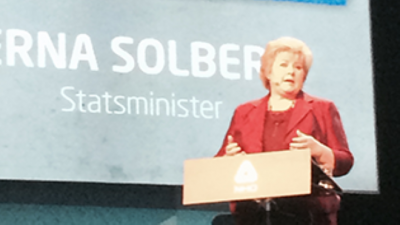After decades of spending billions on bridges and roads in outlying districts of Norway, state politicians finally may start investing more in urban areas where the need for improvements is acute. Prime Minister Erna Solberg signaled more support this week for cities that continue to attract the strongest population growth.

Solberg, speaking at the annual conference of the large Norwegian employers’ organization NHO on Thursday, said the state would become a much better partner for metropolitan areas that have struggled to keep up with strong population growth, especially over the past 20 years. New, binding agreements between the state government and local governments should, Solberg said, ensure more predictable financial support for critical infrastructure such as roads, sewers and public transportation systems, and better urban planning.
Such projects have been neglected in recent years, leading to disruptive congestion and high real estate prices in cities from Oslo to Stavanger, Bergen and Trondheim. While the state transport ministry has spent billions of kroner on tunnels, roads and bridges in remote areas of the country, such projects in metropolitan areas often have been difficult to push through.
The heavy investment in outlying districts is part of Norway’s tradition of “district politics,” aimed at trying to maintain population all over the country and discourage migration to the cities. It has failed, however, to stop the centuries-long flow of Norwegians from countryside to city. Young people still move to the cities to study and find jobs, and often stay there, while the cities also attract the vast majority of immigrants and short-term labour migrants.
The result has been expensive bridges and tunnels used by a handful of people in sparsely populated areas, while hundreds of thousands of commuters in urban areas battle traffic congestion that cuts seriously into productivity, according to NHO (Næringslivets Hovedorganisasjon). While it’s been viewed as politically correct of earlier governments to continue the tradition of spending large amounts of state funds on projects in outlying areas, Solberg’s government coalition of the Conservatives and the Progress Party sees the need to start investing much more in urban areas.

Solberg, noting that Norway’s population is expected to keep growing at a rapid rate, agreed with NHO’s predictions that many people will continue to be attracted to the cities and the strongest business regions. NHO devoted its annual conference largely to the challenges of urban development and transportation, and has called on the state to invest much more heavily than planned in transportation projects over the next 20 years.
Solberg seemed receptive, promising better cooperation in meeting the needs of municipal governments. New ways of thinking, she said “are seldom met with enthusiasm, when we’re warned that the path forward will be different.” She nonetheless thinks its important to “think differently” and pay more attention to urban needs.
Politicians from the small but often powerful Center Party, which champions rural interests and has managed to force through huge investment in outlying districts over the years, objected immediately. The momentum may be with Solberg’s conservative government now, however: “We need functioning metropolitan areas,” Solberg said, stressing that the government would provide “new tools” for stronger partnerships between state and local government, to facilitate development of residential and transportation infrastructure.
newsinenglish.no/Nina Berglund

